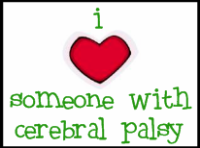What are your best tips for kids with cerebral palsy? That's what I asked an amazing pediatric therapist in honor of National Cerebral Palsy Awareness Day, happening this Sunday March 25. Stacy M. Menz, based in the San Francisco Bay area, has worked with hundreds of kids with CP. She blogs at Starfish Therapies (a great blog, check it out!) and she's a columnist for PediaStaff. I know we all already have more than enough therapy to do with our kids (understatement alert!); what's genius about Stacy's suggestions is that they are basic lifestyle ideas you can easily incorporate into your days. And you're going to love the part where she suggests giving yourself and your kid breaks!
When I sat down to write this, I thought it would be a breeze. Boy, was I wrong. Each item seemed to morph into many items and then I’d realize I still forgot something that I really wanted to share. Writing this list, while thinking of all the children I have seen with CP over the years, made me really appreciate the differences in each child with CP I have met. I know every child with CP is different, but I have tried to make my top points applicable to all!
1. Avoid w-sitting. This is the number one things I tell almost
all of my families. The topic of
w-sitting tends to bring up a lot of controversy usually because parents have
sat this way themselves and have not noticed any detrimental effects. Kids who have CP often sit
this way because it provides them with a really stable base of support allowing
them sit independently. However, that comes at a cost. W-sitting will
also limit and hinder their ability to develop trunk strength, trunk rotation,
hand preference and independent movement in and out of sitting. Tis position also encourages
hamstring tightness, hip and femur alignment issues, and poor posture. Instead of w-sitting work with your
therapists to find some alternatives ways to sit independently as well as work
on other activities.
2. Give kids time to be kids. Kids with CP are often so
scheduled with therapy appointments that they don’t have time to be a kid, goof
off, and do the things other kids do. Give them unstructured play time with their peers or
siblings or even with you. Let them
guide the interaction and see where it will lead. The best part is that usually these
unstructured moments are just as therapeutic as all the structured
therapy. It provides them a great
opportunity for them to work on integrating the skills they learn in therapy
and generalizing it out into their day-to-day environment.
3. Maintain range of motion early. Maintaining range of motion
at various joints in the body can be a challenge when a child has a diagnosis
of CP, especially as they grow and get older. With each growth spurt their muscles can get a little tighter and they
lose just a little bit more range. This
is true for both kids who have low tone and kids who have high tone. Depending on the severity, decreased range of
motion can affect your child’s ability to move, or even the ability to maintain
your child’s hygiene. Start early and
get into the habit of stretching your child or encouraging a multitude of
positions. It’s a lot easier to maintain their range of motion than it is to
get it back. Some areas to pay attention to are your child’s spine, hamstrings,
ankles, hands, and hips.
4. Don't be afraid to take therapy vacations! Its very easy to get caught up in the more-is-better mindset, but at the same time giving your child a break every once in a
while is good for them. It allows their
bodies and brains a chance to take all of the skills and pieces of skills that
they have been practicing over and over and bring it together in a way that
‘clicks’. In addition it gives their
bodies time to rest a bit. Think about training
for a race, taper days are included in the work out program so that your body
can recover; well kids need some recovery time as well! I often find that after a child comes back
from a vacation or a break they will move up to the next level of whatever
skill they have been working on.
5. Know that tone and strength are different. Many kids with CP
have altered muscle tone. This can be
high tone, low tone or mixed tone (a combination of high and low). Low tone is a little easier to see the
underlying weakness and therefore strengthening low tone muscles tends to make
sense. High tone is a little more
challenging because the muscles tend to be "turned on" and stiffer already, so
strengthening seems counterintuitive. The reality is that under that high tone, the muscle is weak and by
strengthening the muscles, it can help the child to regulate and have some
control over their tone. Overall,
strengthening muscles for kids with CP is important because the strength is
what provides them the means to increase their function.
6. Core strengthening is important, too! All strengthening is important—however, the core is the foundation that allows kids to move and to function. The more stable they are in their core the more function they will be able to achieve. A strong core is able to react to changes in balance, sit up tall for increased attention, improve breathing, vocalization and eating, enhances fine motor control, and is involved in almost any activity or function that you want your child to master.
7. Promote independence. Encouraging your child’s
mobility and providing them the resources to have independent mobility can be a
fine line to walk. Many kids with CP are
reliant on their parents, caregivers and aides for mobility and/or
interaction. Providing your child a
means of independent exploration and mobility allows them to explore their
environment, interact with their peers, promote self reliance, and enhances
cognitive skills. Providing them a means
for independent mobility can happen in many ways. It can be power mobility or an
assistive device, or it can be teaching them self directed behavior so that they
don’t need to rely on you for step by step cues on what to do next. Just because you provide them with assistive
devices or wheelchairs doesn’t mean that you have to stop working on
progressing their mobility without the assistive device. In fact, a lot of
times gaining independent movement in an assistive device can help foster the
desire to move and thereby increase their self-motivation. In addition, let your child try tasks
independently even if its messy (like feeding) they feel a sense of
accomplishment when they get to do things on their own.
8. Mix harder stuff with easier stuff. Think about when you are learning a
new skill, how often do you have to practice it until you master it? Quite a bit, I’m sure. During that time required for practice, it’s
energy-consuming both physically and mentally to learn the task. For kids with CP, every new skill requires
exponentially more practice and more energy than when we learn something new.
So what may seem simple to us—such as walking across a room, or eating a meal—can be a workout for a child with CP. But with practice and time, these challenging tasks will get
easier. Don’t give up when something is
really difficult; try mixing it in on a regular basis with easier
activities to prevent frustration for both you and your child. For example, if I'm working on walking with a kiddo and it's hard for them, but they are good at standing or crawling I'll have them practice walking for a bit and then stand at their destination to read a book or play with a toy or use the iPad and then if they want they can crawl back to the 'starting line' where we started practicing walking and try again. This will
provide them with practice of a challenging task and give them a rest (mentally
and/or physically) while successfully completing another task.
9. Encourage your kid to be active every day. Kids are meant
to be active and being active promotes a healthy lifestyle. However, many kids with CP have the tendency
to have poor fitness as a result of their challenges with movement. Encourage this by finding ways to
get them active daily. It doesn’t have
to be structured: Spend time at the
park, go in the water with them, make up games at home, or see what activities
your community offers. Regardless of
your child’s ability to move, there are ways they can be active to promote
their health and, most importantly, have FUN!












Good list. I especially like #5, #6 #7 and #9. Great, thanks!
ReplyDeleteLove that about the therapy vacations and giving them down time. I've been doing both of those for 13 years and it's good to get some validation!
ReplyDeleteGreat article. Thank you.
Fantastic post!
ReplyDeleteThis is a great post! These are great points to try with a child with cerebral palsy. I will keep this in mind and pass on to others!
ReplyDeleteExcellent post. I'm printing it for my parent file.
ReplyDeleteExcellent post. I'm printing it for my parent file.
ReplyDeleteThis is good advice for most children, special needs or not - keep active, have good posture, take time to play, etc.
ReplyDeleteOur therapists are always correcting my ASD son's W-sitting & he does have poor core strength, often using one hand to brace himself while doing seated activities. I always forget b/c I'm too used to seeing it. And when I've mentioned it to certain grandparents, they look at me like, what are those therapists talking about? Silly nonsense. Argh.
What is W-sitting? Thank you for sharing also.
ReplyDeleteWhen kids sit with their knees bent and legs behind them, angled in a w shape. You can see a photo of it here: http://childrenstherapy.org/w-sitting-fix-or-forget/
DeleteAs a 55 yo adult living with cp. Don't say to the child I'm sorry that you I disabled. I want no sadness or pitty my life has been and will be full in every way I am married own my home and have become a landlord to a younger brother. Darn good for a cp kid the drs said would never be able to care for herself at all!
ReplyDelete